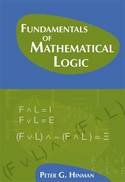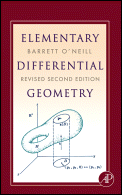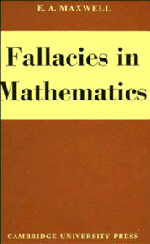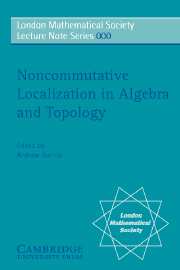Peter G. Hinman
Fundamentals of Mathematical Logic
Summary
 This introductory graduate text covers modern mathematical logic
from propositional, first-order and infinitary logic and Godelfs
Incompleteness Theorems to extensive introductions to set theory,
model theory and recursion (computability) theory.
This introductory graduate text covers modern mathematical logic
from propositional, first-order and infinitary logic and Godelfs
Incompleteness Theorems to extensive introductions to set theory,
model theory and recursion (computability) theory.
Based on the authorfs more than 35 years of teaching
experience, the book develops studentsf intuition by presenting
complex ideas in the simplest context for which they make sense.
The book is appropriate for use as a classroom text, for self-study,
and as a reference on the state of modern logic.
Details
ISBN: 1-56881-262-0
Year: 2005
Format: Hardcover
Pages: 896
Reviews
gI expect this book to become the standard graduate logic text
for the new century, based on the enthusiastic reception from
students in our course last year.h
Doug Cenzer
Recommendations
Customers who bought this item also bought:
The Incompleteness Phenomenon
On Quaternions and Octonions
Logic Colloquium f99: Lecture Notes in Logic 17
Inexhaustibility: A Non-Exhaustive Treatment: Lecture Notes in
Logic 16
The Honors Class: Hilbertfs Problems and Their Solvers
Barrett O'Neill
University of California, Los Angeles, California, U.S.A.
Elementary Differential Geometry, Revised 2nd Edition
 Written primarily for students who have completed the standard first courses
in calculus and linear algebra, ELEMENTARY DIFFERENTIAL GEOMETRY, REVISED
SECOND EDITION, provides an introduction to the geometry of curves and
surfaces.
Written primarily for students who have completed the standard first courses
in calculus and linear algebra, ELEMENTARY DIFFERENTIAL GEOMETRY, REVISED
SECOND EDITION, provides an introduction to the geometry of curves and
surfaces.
The Second Edition maintained the accessibility of the first,
while providing an introduction to the use of computers and
expanding discussion on certain topics. Further emphasis was
placed on topological properties, properties of geodesics,
singularities of vector fields, and the theorems of Bonnet and
Hadamard.
This revision of the Second Edition provides a thorough update of
commands for the symbolic computation programs Mathematica or
Maple, as well as additional computer exercises. As with the
Second Edition, this material supplements the content but no
computer skill is necessary to take full advantage of this
comprehensive text.
Contents
Preface
Introduction
Chapter 1: Calculus on Euclidean Space:
Euclidean Space. Tangent Vectors. Directional Derivatives. Curves
in R3. 1-forms. Differential Forms. Mappings.
Chapter 2: Frame Fields:
Dot Product. Curves. The Frenet Formulas. ArbitrarySpeed Curves.
Covariant Derivatives. Frame Fields. Connection Forms. The
Structural Equations.
Chapter 3: Euclidean Geometry:
Isometries of R3. The Tangent Map of an Isometry. Orientation.
Euclidean Geometry. Congruence of Curves.
Chapter 4: Calculus on a Surface:
Surfaces in R3. Patch Computations. Differentiable Functions and
Tangent Vectors. Differential Forms on a Surface. Mappings of
Surfaces. Integration of Forms. Topological Properties. Manifolds.
Chapter 5: Shape Operators:
The Shape Operator of M R3. Normal Curvature. Gaussian Curvature.
Computational Techniques. The Implicit Case. Special Curves in a
Surface. Surfaces of Revolution.
Chapter 6: Geometry of Surfaces in R3:
The Fundamental Equations. Form Computations. Some Global
Theorems. Isometries and Local Isometries. Intrinsic Geometry of
Surfaces in R3. Orthogonal Coordinates. Integration and
Orientation. Total Curvature. Congruence of Surfaces.
Chapter 7: Riemannian Geometry: Geometric Surfaces. Gaussian
Curvature. Covariant Derivative. Geodesics. Clairaut
Parametrizations. The Gauss-Bonnet Theorem. Applications of Gauss-Bonnet.
Chapter 8: Global Structures of Surfaces: Length-Minimizing
Properties of Geodesics. Complete Surfaces. Curvature and
Conjugate Points. Covering Surfaces. Mappings that Preserve Inner
Products. Surfaces of Constant Curvature. Theorems of Bonnet and
Hadamard.
Appendix
Bibliography
Answers to Odd-Numbered Exercises
Subject Index
Rudolf Freund / William Wilson / Ping Sa
Regression Analysis , Second Edition
Complete discussion of analysis of data including
estimation, diagnostics, and remedial actions
Examples and exercises contain real data and
graphical illustration for ease of interpretation
Outputs from SAS 7, SPSS 7, Excel, and Minitab are
used for illustration, but any major statistical
software package will work equally well
Data sets are furnished on data diskette and on web page
Reviews
"...is well-written , well-organized, and succeeds in making
regression analysis understandable, without being overly
technical." Donice McCune, Stephen F. Austin University
"I would say that this book is excellent from both a
pedagogical perspective and a learning perspective (by the
student). The instructor will enjoy discussing various concepts
and then illustrating the concepts through the thorough examples.
6. This textbook will help give the students additional
mathematical maturity for handling other statistics courses,
especially applied courses like Analysis of Variance."
Steven Garren, James Madison University
Description
The book provides complete coverage of the Aclassical methods of
statistical analysis. It is designed to give students an
understanding of the purpose of statistical analyses, to allow
the student to determine, at least to some degree, the correct
type of statistical analyses to be performed in a given
situation, and have some appreciation of what constitutes good
experimental design.
Contents
1. The Analysis of Means: A Review of Basics and an
Introduction to Linear Models
2. Simple Linear Regression:Linear Regression with
One Independent Variable
3. Multiple Regression
4. Problems with Observations
5. Multicollinearity
6. Problems with the Model
7. Curve Fitting
8. Introduction to Nonlinear Models
9. Indicator Variables
10. Categorical Response Variables
11. Generalized Linear Models
Appendix A: Statistical Tables
Appendix B: A Brief Introduction to Matrices
Appendix C: Estimation Procedures
References
Readership: Because of the universal appeal of statistics and
statistical methodology, most graduate programs include as part
of their curriculum one or two course in statistical methods. In
addition, undergraduate students majoring in mathematics or
statistics are required or encouraged to take courses in
statistical methods. This book is intended to serve as a text for
such courses. The book requires no mathematics beyond algebra,
however, mathematically oriented students will still find the
material in the text challenging.
ISBN: 0-12-088597-2 Book/Hardback
Line Illustrations: 84
Measurements: 7 1/2 X 9 1/4 in
Pages: 464
10 March 2006
E. A. Maxwell
Fallacies in Mathematics
Paperback (ISBN-10: 0521026407 | ISBN-13: 9780521026406)
Hardback (ISBN-10: 0521057000 | ISBN-13: 9780521057004)
January 2006
 As Dr Maxwell writes in his preface to this book, his aim has
been to instruct through entertainment. eThe general theory is
that a wrong idea may often to exposed more convincingly by
following it to its absurd conclusion than by merely announcing
the error and starting again. Thus a number of by-ways appear
which, it is hoped, may amuse the professional, and help to tempt
back to the subject those who thought they were losing interestf.
The standard of knowledge expected is fairly elementary. In most
cases a straightforward statement of the fallacious argument is
followed by an exposure in which the error is traced to the most
elementary source, and this process often leads to an analysis
which is often of unexpected depth. Many students will discover
just how mathematically-minded they are when they read this book;
nor is that the only discovery they will make. Teachers of
mathematics in schools and technical schools, colleges and
universities will also be sure to find something here to please
them.
As Dr Maxwell writes in his preface to this book, his aim has
been to instruct through entertainment. eThe general theory is
that a wrong idea may often to exposed more convincingly by
following it to its absurd conclusion than by merely announcing
the error and starting again. Thus a number of by-ways appear
which, it is hoped, may amuse the professional, and help to tempt
back to the subject those who thought they were losing interestf.
The standard of knowledge expected is fairly elementary. In most
cases a straightforward statement of the fallacious argument is
followed by an exposure in which the error is traced to the most
elementary source, and this process often leads to an analysis
which is often of unexpected depth. Many students will discover
just how mathematically-minded they are when they read this book;
nor is that the only discovery they will make. Teachers of
mathematics in schools and technical schools, colleges and
universities will also be sure to find something here to please
them.
Contents
Preface; 1. The mistake, the howler and the fallacy; 2. Four
geometrical fallacies enunciated; 3. Digression on elementary
geometry; 4. The eIsoceles Trianglef fallacy analysed; 5. The
other geometrical fallacies analysed; 6. Some fallacies in
algebra and trigonometry; 7. Fallacies in differentiation; 8.
Fallacies in integration; 9. Fallacy by the circular points at
infinity; 10. Some eLimitf fallacies; 11. Some miscellaneous
howlers.
Edited by Andrew Ranicki
Noncommutative Localization in Algebra and Topology
Series: London Mathematical Society Lecture Note Series (No.
330)
Paperback (ISBN-10: 052168160X | ISBN-13: 9780521681605)
January 2006
 Noncommutative localization is a powerful algebraic technique for
constructing new rings by inverting elements, matrices and more
generally morphisms of modules. Originally conceived by
algebraists (notably P. M. Cohn), it is now an important tool not
only in pure algebra but also in the topology of non-simply-connected
spaces, algebraic geometry and noncommutative geometry. This
volume consists of 9 articles on noncommutative localization in
algebra and topology by J. A. Beachy, P. M. Cohn, W. G. Dwyer, P.
A. Linnell, A. Neeman, A. A. Ranicki, H. Reich, D. Sheiham and Z.
Skoda. The articles include basic definitions, surveys,
historical background and applications, as well as presenting new
results. The book is an introduction to the subject, an account
of the state of the art, and also provides many references for
further material. It is suitable for graduate students and more
advanced researchers in both algebra and topology.
Noncommutative localization is a powerful algebraic technique for
constructing new rings by inverting elements, matrices and more
generally morphisms of modules. Originally conceived by
algebraists (notably P. M. Cohn), it is now an important tool not
only in pure algebra but also in the topology of non-simply-connected
spaces, algebraic geometry and noncommutative geometry. This
volume consists of 9 articles on noncommutative localization in
algebra and topology by J. A. Beachy, P. M. Cohn, W. G. Dwyer, P.
A. Linnell, A. Neeman, A. A. Ranicki, H. Reich, D. Sheiham and Z.
Skoda. The articles include basic definitions, surveys,
historical background and applications, as well as presenting new
results. The book is an introduction to the subject, an account
of the state of the art, and also provides many references for
further material. It is suitable for graduate students and more
advanced researchers in both algebra and topology.
Contents
Dedication; Preface; Historical perspective; Conference
participants; Conference photo; Conference timetable; 1. On
flatness and the Ore condition J. A. Beachy; 2. Localization in
general rings, a historical survey P. M. Cohn; 3. Noncommutative
localization in homotopy theory W. G. Dwyer; 4. Noncommutative
localization in group rings P. A. Linnell; 5. A non-commutative
generalisation of Thomasonfs localisation theorem A. Neeman; 6.
Noncommutative localization in topology A. A. Ranicki; 7. L2-Betti
numbers, isomorphism conjectures and noncommutative localization
H. Reich; 8. Invariants of boundary link cobordism II. The
Blanchfield-Duval form D. Sheiham; 9. Noncommutative localization
in noncommutative geometry Z. Skoda.
 This introductory graduate text covers modern mathematical logic
from propositional, first-order and infinitary logic and Godelfs
Incompleteness Theorems to extensive introductions to set theory,
model theory and recursion (computability) theory.
This introductory graduate text covers modern mathematical logic
from propositional, first-order and infinitary logic and Godelfs
Incompleteness Theorems to extensive introductions to set theory,
model theory and recursion (computability) theory. Written primarily for students who have completed the standard first courses
in calculus and linear algebra, ELEMENTARY DIFFERENTIAL GEOMETRY, REVISED
SECOND EDITION, provides an introduction to the geometry of curves and
surfaces.
Written primarily for students who have completed the standard first courses
in calculus and linear algebra, ELEMENTARY DIFFERENTIAL GEOMETRY, REVISED
SECOND EDITION, provides an introduction to the geometry of curves and
surfaces.  As Dr Maxwell writes in his preface to this book, his aim has
been to instruct through entertainment. eThe general theory is
that a wrong idea may often to exposed more convincingly by
following it to its absurd conclusion than by merely announcing
the error and starting again. Thus a number of by-ways appear
which, it is hoped, may amuse the professional, and help to tempt
back to the subject those who thought they were losing interestf.
The standard of knowledge expected is fairly elementary. In most
cases a straightforward statement of the fallacious argument is
followed by an exposure in which the error is traced to the most
elementary source, and this process often leads to an analysis
which is often of unexpected depth. Many students will discover
just how mathematically-minded they are when they read this book;
nor is that the only discovery they will make. Teachers of
mathematics in schools and technical schools, colleges and
universities will also be sure to find something here to please
them.
As Dr Maxwell writes in his preface to this book, his aim has
been to instruct through entertainment. eThe general theory is
that a wrong idea may often to exposed more convincingly by
following it to its absurd conclusion than by merely announcing
the error and starting again. Thus a number of by-ways appear
which, it is hoped, may amuse the professional, and help to tempt
back to the subject those who thought they were losing interestf.
The standard of knowledge expected is fairly elementary. In most
cases a straightforward statement of the fallacious argument is
followed by an exposure in which the error is traced to the most
elementary source, and this process often leads to an analysis
which is often of unexpected depth. Many students will discover
just how mathematically-minded they are when they read this book;
nor is that the only discovery they will make. Teachers of
mathematics in schools and technical schools, colleges and
universities will also be sure to find something here to please
them. Noncommutative localization is a powerful algebraic technique for
constructing new rings by inverting elements, matrices and more
generally morphisms of modules. Originally conceived by
algebraists (notably P. M. Cohn), it is now an important tool not
only in pure algebra but also in the topology of non-simply-connected
spaces, algebraic geometry and noncommutative geometry. This
volume consists of 9 articles on noncommutative localization in
algebra and topology by J. A. Beachy, P. M. Cohn, W. G. Dwyer, P.
A. Linnell, A. Neeman, A. A. Ranicki, H. Reich, D. Sheiham and Z.
Skoda. The articles include basic definitions, surveys,
historical background and applications, as well as presenting new
results. The book is an introduction to the subject, an account
of the state of the art, and also provides many references for
further material. It is suitable for graduate students and more
advanced researchers in both algebra and topology.
Noncommutative localization is a powerful algebraic technique for
constructing new rings by inverting elements, matrices and more
generally morphisms of modules. Originally conceived by
algebraists (notably P. M. Cohn), it is now an important tool not
only in pure algebra but also in the topology of non-simply-connected
spaces, algebraic geometry and noncommutative geometry. This
volume consists of 9 articles on noncommutative localization in
algebra and topology by J. A. Beachy, P. M. Cohn, W. G. Dwyer, P.
A. Linnell, A. Neeman, A. A. Ranicki, H. Reich, D. Sheiham and Z.
Skoda. The articles include basic definitions, surveys,
historical background and applications, as well as presenting new
results. The book is an introduction to the subject, an account
of the state of the art, and also provides many references for
further material. It is suitable for graduate students and more
advanced researchers in both algebra and topology.